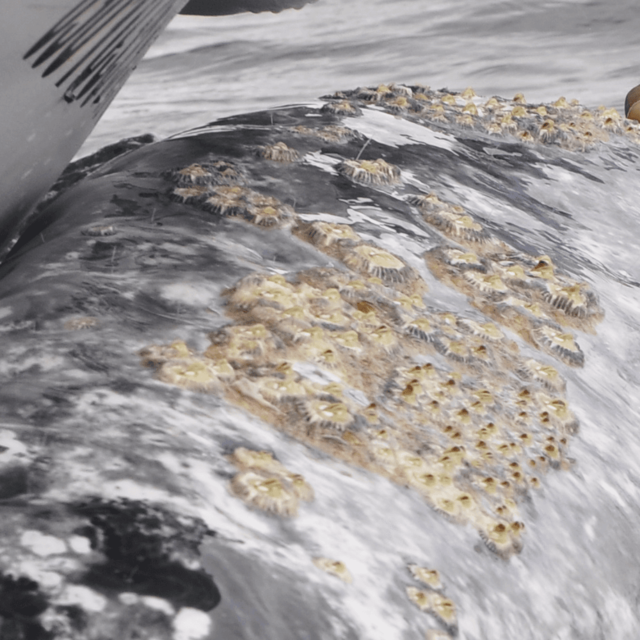Gray Whale Barnacles

Cryptolepas rhachianecti
The Gray Whale Barnacle
Barnacles are the most visually noticeable “parasite” that live upon the Gray Whales.
Here’s the taxonomy of the Gray Whale barnacle.
Cryptolepas rhachianecti = scientific name
Kingdom: Animalia
Phylum: Arthropoda
Subphylum: Crustacea
Class: Maxillopoda
Subclass: Thecostraca
Infraclass: Cirripedia
Order:
Family:
Genus: Cryptolepas
Species: rhachianecti
Sometimes whale lice squeeze themselves into the space between the shell and the actual body of the whale barnacle. This can create a tight living quarters and might lead to attack by a few whale lice upon the host barnacle. But generally the whale lice simply use the inside of the barnacle shell as shared living accommodations. Living on a whale, the barnacle has become a moving target, is free from attack by most of the common barnacle predators and is much more difficult prey for fish to feed upon. The life cycle of the Gray Whale barnacle is in rhythm and synchronized with the migration cycle of the whale. The barnacles actually reproduce when the whales are in the warmer southern waters off the coast of Mexico and when the whales are inside the secure and calm lagoons or bays of Laguna Ojo de Liebre, San Ignacio and Magdalena Bay. By reproducing inside the enclosed lagoons, the free swimming barnacle larvae have thousands of times more opportunity to successfully locate a viable host animal. With hundreds of gray whales per square kilometer of water area inside the lagoons, compared to thousands of square kilometers of water area per host animal in the Bering Sea and other northern Gray Whale habitats it is clear that the opportunity to land successfully is significantly increased inside the lagoons. If the reproduction took place in the cold northern waters during the Gray Whale’s feeding period, most of the barnacle larvae would simply fall to the bottom of the ocean or become prey to planktonic marine feeding animals. This is the most likely cause of the Gray Whale population having far more barnacles living upon them, than any other species of whale. Lots of whales in a relatively small area and millions of barnacle larvae searching for a good home.
So, just what is the life cycle of a gray whale barnacle?
Barnacles are obligate cross-fertilizing hermaphrodites. They can mate with any nearby barnacle. Inside the barnacle shell is a relatively long tubular penis 4” to 8” long. When ready to mate the barnacle protrudes this tube outside the shell and begins to search the nearby vicinity for a receptive fellow barnacle. The tube is then inserted into that receptor barnacle and sperm is deposited, thus fertilizing a portion of as many as 10,000 eggs. The temporarily female barnacle must be fertilized several times, perhaps by several “male” barnacles at different times in order for all of the eggs to be fertilized.
The eggs are brooded inside the mantle of the barnacle for a short period of time. Brooding varies among barnacle species and can be up to several months duration. But we know that small barnacles are visible upon whales within days or weeks of their arrival in the lagoons. Thus the conclusion is that these whale barnacles have a brief egg brooding period.
The eggs develop into a form called nauplius or nauplius larvae. These naupli are released into the ocean where they are free swimmers and become part of the planktonic soup.
These small crustaceans (yes, barnacles are closely related to creatures like shrimp and lobsters) have developed a life cycle that is closely tied to the Gray Whale migration. The barnacles have also adapted physically to their mobile environment. Instead of a tall rough shell like the stationary, upright, drag causing barnacles that grow on ships and rocks, the Whale barnacles have adapted to have a sleek and streamlined form, thus immensely reducing the drag they cause.
Writers and researchers generally say that whale barnacles get a free ride to food and this is the number one benefit they derive from life on board their whale associate. I rank delivery to a food source as the secondary benefit, not the primary benefit for the barnacles.
There is a much more obvious benefit that the barnacle species derives from living upon the back of the whale, one that is commonly overlooked in discussions about whale barnacles. This is the security that being mobile provides to the barnacle. Living upon the back of a Gray Whale means they are free from attacks by the most common enemies of the various barnacle species.
Stationary barnacles are regularly attacked and eaten by sea stars (starfish), sea cucumbers, some sea worms, as well as various snails and whelks. Small fish find it easy to hover over barnacles and nibble at the animal as it extends itself from the protective shell to feed upon passing plankton. Larger, heavily toothed fish, such as Sheepshead, can actually crunch the tough limestone shell to get to the barnacle inside.
Living upon the back (or bottom) of a gray whale the barnacles never need to worry about any of the common invertebrates that prey upon the stationary forms of barnacle. Some small fish in search of food do follow the Gray Whales when they are in the Baja Lagoons. These small fish eat food that is stirred up by the gray whales from the shallow bottom of the lagoons. These small fish also prey upon whale lice and very occasionally upon barnacles.
The photo to the left is a close up of a single whale barnacle, open and feeding. The scale is about 2 to 4 times life size.
The living barnacle is the light yellow colored membrane, with the open cirria or filter membrane showing inside.
There are three large (about 1/2 “ to 1” long) whale lice in the space between the barnacle and the barnacle shell.
The darker gray color is the barnacle shell.
Photo – copyright 2008, Keith Jones Equipment: Nikon D70 with 200 mm Nikor macro close up lens, handheld and using natural lighting in a live situation.
In their adult life form it is difficult to visualize the barnacle as being related to lobsters or other crustaceans. But in their free swimming naupli form, the young barnacles (when viewed through a microscope) can be seen to have antenna, an eye, jointed legs and an armor plate-like body structure. The legs to swim with are necessary because the microscopic naupli feed on even smaller plankton during this period of their lives. As the young barnacle, in the nauplius form grows, it must molt and grow new shells. Molting occurs several times. I cannot tell you how many molts a gray whale barnacle goes through and perhaps nobody knows. I welcome the answer, if it is known by any of the highly knowledgeable marine experts who subscribe to The Gray Whale Advocate.
The naupli metamorphose into the next phase of barnacle development, called the cyprid larval stage. At this stage in the life cycle the barnacle does not feed. It has now become a seek and sit life form. Instead of a hunter as in the naupli stage, the cyprid’s goal in life is to find an acceptable location to settle down, cement itself there and then grow into an adult barnacle. The cyprids have legs or arms, appendages of some type (call them what you will) protruding from the body. These appendages are chemical and touch sensitive. The cyprid now incessantly searches for other barnacles of like type. They can tell this by touch. There is belief amongst scientists that cyprids can detect chemical signatures unique to the gray whale host and to their own species and then follow this chemical trail to find a host animal. Once the cyprid determines it has located a satisfactory home it lands upon the host animal.
The cyprid has an arm-like appendage that protrudes from the head or front of the tiny animal. This arm is pushed against the skin of the whale and a specialized glue producing gland then secretes the “magic” glue that sticks the cyprid permanently in place. At this point in time the cyprid rotates so its feathers (called cirri) are aimed outward. The barnacle during the landing phase must push its arm or landing antenna down into the skin of the gray whale to afford a better grasp upon the animal.
The limestone barnacle shell then begins to form around the carapace of the cyprid, which is now seen on gray whales as tiny pointy baby barnacles. The growing barnacle must molt several times, until after 6 to 10 months the adult barnacle is full grown. When we see baby whales, they have baby barnacles visible within days of being born. Thus if you see a baby whale with no barnacles around the blowhole or V of the tail, that baby is almost certainly less than a week old. I have been studying the lives of Gray Whales since 1994 and in all that time I have only seen one gray whale that did not have any barnacles. That whale was known as JJ, a rescued baby Gray Whale. JJ lived at Sea World in San Diego for one year. JJ probably lost contact with his mother at birth and thus never developed any barnacle clusters. Because he had no barnacles, he also had no gray or white patches of skin. JJ was the only black Gray Whale I have ever seen. Those of you who have traveled with me to Baja to see whales have heard the story of JJ. If you haven’t heard the tale, come along some time and ask to hear this story about one unique whale.
